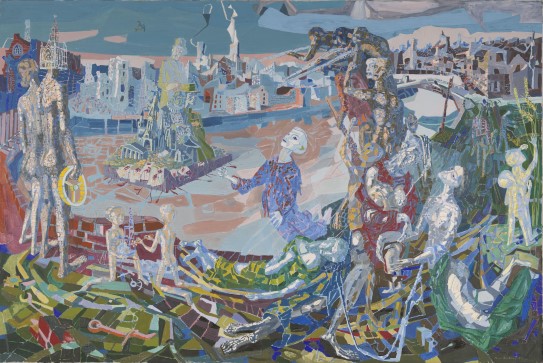The Last Shots
Arne Ekeland
Transcription
Lin Stafne-Pfisterer:
Ekeland was a man who was very engaged in politics. He was openly communist, and he also expressed his views in his paintings.
Narrator:
The National Museum’s Lin Stafne-Pfisterer is talking about the artist Arne Ekeland, who was born in Bøn, about 60 km north of Oslo, in 1908. After completing his painting studies, and following a period living in Paris in the 1930s, Ekeland submitted a comprehensive proposal for murals to decorate the recently completed Oslo City Hall. He was deeply disappointed when his proposal was rejected, but not long after, his career started to take off.
Lin Stafne-Pfisterer:
This painting, The Last Shots, may have been the final work he completed before the opening of his exhibition at Kunstnernes Hus on the 29th of March 1940, just days before war broke out.
Narrator:
To start with, the exhibition was a brilliant success. Ekeland sold many of his paintings in the first few days. His painting The last shots was bought by the wealthy banker and art collector Johannes Sejersted Bødkter.
Lin Stafne-Pfisterer:
This was very fortunate. Because after the invasion on the 9th of April, the exhibition was taken down, the canvases were taken off their stretchers and rolled up, and everything that hadn’t been sold was hidden away. When we look at The last shots, it feels as though a powerful wave is sweeping through the painting from right to left, culminating in a column of people. These people are soldiers who are actually shooting straight at other people who have sought refuge on an island. And who are these targets? They are a priest, a wealthy businessman and a soldier, representing the church, capitalist society and the military. In the background, we see a bombed city, while in the foreground of the painting we see hope, as there we see children rebuilding the city. And to the very far right of the painting we can see a field and someone growing wheat, so that represents hope for the future.
Narrator:
After The last shots had hung in the collector Johannes Sejersted Bødkter’s home for many years, the National Gallery bought the painting in 1965. Ekeland’s hardline political views are particularly apparent in this painting, with gunshots marking a violent start to a revolutionary new era.
Lin Stafne-Pfisterer: And of course these views were hugely in contrast with those of the people who actually bought his paintings, and for a long time, right up until the present day, it’s been possible to see this contrast in all sorts of business premises: paintings hanging on the walls that communicate the message of this true-red communist. But that’s how it is with art. It has its own power, and to many people the aesthetic aspect is just as important.